#Paleontologists
Explore tagged Tumblr posts
Text

225 notes
·
View notes
Text







STEGOSAURUS WYOMING, USA
From the Meilyn Quarry, Medicine Bow, Carbon County, Wyoming, Late Jurassic (circa 157-145 million years ago). The specimen of Stegosaurus sp. preserved with fossil bones of a black colour; approximately 144 fossil bone elements with additional cast, sculpted and 3D printed material, mounted on custom frame.
Initial excavation in 2002. Quarry and specimen acquired by current owner 2008. Additional excavation campaigns 2017-2018. Final prep work and mounting in Germany, 2023.
Sold at auction for almost $5,400,000.
#Stegosaurus#STEGOSAURUS WYOMING USA 2002#Late Jurassic#dinosaur#paleontologists#fossils#ancient artifacts#archeology#archeolgst#history#history news#ancient history
34 notes
·
View notes
Text
Paleontologist Dr Kenneth Lacovara: 'There have been five past mass extinctions. And every one was caused by a climate crisis-- the last, a climate crisis caused by an asteroid impact [that killed all life on the surface of the planet]. We are experiencing a sixth extinction, right now. We're not quite at the levels, obviously, that happened when the dinosaurs were wiped out. But the rate of extinction that's happening right now, if it persists, will lead to Earth's sixth extinction.'
youtube
'During the last 2 million years, we loose about 9 species per century. Well, just in the last century, we have lost 615 species of vertebrate animals.
Since 1970, there are 69% fewer wild animals on the land.'
#paleontologists#dr kenneth lacovara#climate change#the sixth extinction#dinosaurs#the earth is definitely doomed#congrats everyone#we are in the 6th extinction and we are all doomed#i kind of feel like this is appropriate#humans have fucked up the world way too much#maybe it's best if the earth can try again with a better group#Youtube
10 notes
·
View notes
Text
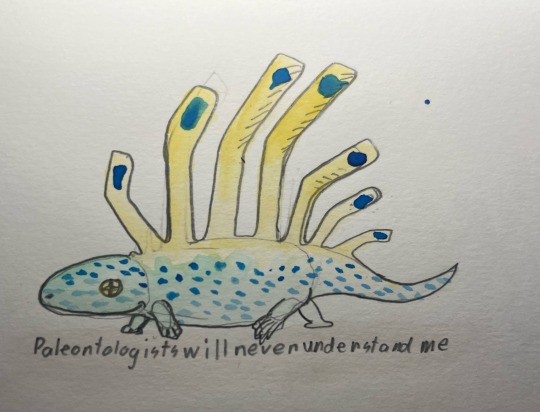
longisquama
#longisquama#Paleontologists will never understand me#paleo meme#paleoillustration#paleo art#paleontologist#paleo#paleoblr#paleoart#paleomedia#paleontology#paleostream#paleontologists#lizards#frilled lizard#watercolor#traditional sketch#pencil
64 notes
·
View notes
Link
The fossil record is biased against bats. The flying mammals are small, making their fossilized remains very hard to find. And their light skeletons—ideal for flying around—mean it takes special circumstances for their bodies to be preserved. And yet, against these odds, paleontologists recently uncovered the exceptionally complete skeleton of what now stands as the earliest known bat.
To date, the most complete early bat fossils have come from an area paleontologists call Fossil Lake in Wyoming. The rock layers are world-famous for containing beautifully preserved fish, birds, mammals and other organisms that lived in the area about 52 million years ago. Among the stunning fossils recovered from these rocks, Naturalis Biodiversity Center paleontologist Tim Rietbergen and colleagues report Wednesday in PLOS One, are fossils of a new bat species the researchers have named Icaronycteris gunnelli. By comparing this new species with other early bats, paleontologists are beginning to develop a deeper understanding of how bats spread around the world in that period.
Continue Reading
193 notes
·
View notes
Text
Tonight's Live stream
I hope many of you will be tuning in to the live stream about the knew Allosaurus species. It will be broadcast on three platforms.
See you there!
3 notes
·
View notes
Text
youtube
0:00 - Introduction
Welcome to the Juras-Sick Park-Cast podcast, the Jurassic Park podcast about Michael Crichton's 1990 novel Jurassic Park, and also not about that, too. Find the episode webpage at: Episode 38 - Tim. www.jurassickparkcast.blogspot.com/2022/11/episode-38-tim.html
07:25 - Interview with terrific guest Dr. Roger Lederer
In this episode, my terrific guest Dr. Roger J. Lederer joins the show to chat with me about:
16:03 - Lederer's "Role of Rictal Bristles" paper
37:30 - Paleontological papers referencing Lederer's paper on rictal bristles
47:43 - the names of birds and dinosaurs
turkeys, Thanksgiving, turkey vultures, disposing of carcasses, registering domain names, the fastest birds, ostriches, the bustard, the elephant bird, rictal bristles, flycatchers, studying birds, DNA, Watson and Crick, cloning extinct animals, Loy's procedure, reverse breeding aurochs, birds are dinosaurs!, archaeopteryx, the evolution of feathers, the feather-colour of microraptors, enantiornithines, Dr. Richard Prum and the evolution of feathers, theories on the evolution of feathered flight, herons hunting, Crichton using Lederer's name in the text!, the Hoatzin, A Reappraisal of Azhdarchid Pterosaur Functional Morphology and Paleoecology; Bristles before down: A new perspective on the functional origin of feathers; A review of the Taxonomy and Paleoecology of the Anuro-gnathidae, strange feather uses, ubirajara jubatus, "raptor" nomenclature, tyrannidae, birds being territorial and mean, cassowaries, The Gobbler!, and much more!
You can find way more neat bird data on Dr. Lederer's website www.ornithology.com.
Plus dinosaur news about:
02:14 - A new ‘duck-billed’ dinosaur(Ornithischia: Hadrosauridae) from the upper Campanian of Texas points to agreater diversity of early hadrosaurid offshoots
04:21 - The role of Avian Rictal Bristles
00:36 - Featuring the music of Snale https://snalerock.bandcamp.com/releases
Intro: Grow Old Or Don't.
Outro: Centipede.
The Text: This week’s text is Tim, spanning from pages 204 – 210.
57:58 - Synopsis of the chapter Tim, from Jurassic Park
A concussed Tim Murphy awakes from the tyrannosaur attack to find himself trapped in a car, atop a tree. He climbs out of the tree, as the Land Cruiser crashes down above him.
01:02:54 - Analyzing the literary and stylistic techniques in the chapter Tim
01:13:27 - Discussions surround Show Don't Tell, Storytelling and Tension
Corrections:
Side effects: May cause you to totally miss the point.
Find it on iTunes, on Spotify (click here!) or on Podbean (click here). Thank you! The Jura-Sick Park-cast is a part of the Spring Chickens banner of amateur intellectual properties including the Spring Chickens funny pages, Tomb of the Undead graphic novel, the Second Lapse graphic novelettes, The Infantry, and the worst of it all, the King St. Capers. You can find links to all that baggage in the show notes, or by visiting the schickens.blogpost.com or finding us on Facebook, at Facebook.com/SpringChickenCapers or me, I’m on twitter at @RogersRyan22 or email me at ryansrogers-at-gmail.com. Thank you, dearly, for tuning in to the Juras-Sick Park-Cast, the Jurassic Park podcast where we talk about the novel Jurassic Park, and also not that, too. Until next time!





#dinosaurs#youtube#jurassic park#michael crichton#dinosaur movies#dinosaur#podcast#paleontology#ornithology#birds#Dr. Alan Grant#malefica deckerti#rictal bristles#pterosaurs#paleontologists#Youtube
6 notes
·
View notes
Text
Fascinating story.
75 notes
·
View notes
Note
im not sure if this counts but i acnt really find much info om how much the ratio of body size to wing ratios it would require for a mordern pterodactyl to take off without having to use its forelimbs?
Also if anyone has any aerodynamics programs i would love to see them
Thanks
Anyone on here a paleontologist? Or know about aerodynamics?
(This is from our research game!)
You guys know the drill, send this around until we find someone who knows!
(If not, this sounds like a situation that you could fictionalize. Send me a message if you want to talk more about it!)
#dinosaurs#paleontology#paleontologist#paleontologists#science#science side of tumblr#aerodynamics#the research game#research
14 notes
·
View notes
Text
"you can't judge people in the past" doesn't even apply to past paleontologists.
Y'all telling me they couldn't find a single butcher to ask about how to puzzle them bones?
Nah. They were dumb rich kids and you can't prove me wrong.
(I also don't know shit about Chinese paleontology history. Or any other country actually. I wonder who got closest fastest)
((also also the bone wars))
(((tangent. Did you hear what that one guy did to Troy?)))
#sally only sold the sea shells#she didn't puzzle together a salamander and say Behold A Man#paleontologists#paleontology#bad science#no consultation#no second opinions#history#don't meet your heroes#don't repeat the bone wars
3 notes
·
View notes
Link
Tutti conoscono l'estinzione di massa che pose fine all'era dei dinosauri. Circa 66 milioni di anni fa, un asteroide largo sette miglia si schiantò sul nostro pianeta e diede inizio a un'estinzione di massa che spazzò via tutti i dinosauri , fatta eccezione per gli uccelli dal becco , per non parlare di circa il 75 percento delle specie conosciute. Ma un'estinzione di massa diversa fu responsabile del successo dei dinosauri. Circa 201 milioni di anni fa, incredibili eruzioni vulcaniche nel supercontinente Pangea sconvolsero la vita sulla Terra e diedero ai primi dinosauri la possibilità di prosperare.
I paleontologi sanno che tra la fine del periodo Triassico e l'inizio del Giurassico è accaduto qualcosa di strano per la maggior parte di un secolo. Negli ultimi giorni del Triassico, i primi dinosauri vivevano accanto ad anfibi giganti, fitosauri simili ai gaviali e una serie di parenti dei coccodrilli che assumevano forme che andavano da quelle simili agli armadilli a quelle dei predatori al vertice. Nelle prime rocce del Giurassico, tuttavia, alcuni di questi gruppi scomparvero completamente e altri subirono una grave riduzione della diversità quando i dinosauri iniziarono a proliferare. Anche i mari videro cambiamenti nella composizione della barriera corallina, crolli improvvisi del plancton e la scomparsa di ittiosauri delle dimensioni di una balena, mentre i loro parenti più piccoli continuarono a vivere nello stesso periodo. I cambiamenti nella biodiversità della Terra sono le increspature di uno degli eventi più catastrofici nella storia del nostro pianeta.
L'estinzione del Triassico-Giurassico non fu così rapida o violenta nelle sue conseguenze come l'impatto dell'asteroide di 66 milioni di anni fa. Per quanto i paleontologi siano stati in grado di ricostruire l'antica Terra all'epoca, l'estinzione fu una lunga serie di cambiamenti climatici e ambientali. L'innesco più probabile sono le incredibili espulsioni di gas serra in quella che gli esperti chiamano la Provincia Magmatica dell'Atlantico Centrale (CAMP). Gli antichi vulcani in quell'area, situati attorno al centro della Pangea, trasudavano e ruttavano gas serra a impulsi per oltre 600.000 anni, ricoprendo circa tre milioni di miglia quadrate di roccia vulcanica e causando brusche oscillazioni climatiche tra caldo e freddo. "Con un rilascio così rapido di anidride carbonica, anidride solforosa, fuliggine e altri gas termogenici, si verifica una cascata di effetti", afferma la geologa Victoria Petryshyn dell'Università della California del Sud. Pioggia acida, aumento delle radiazioni UV dovute all'esaurimento dell'ozono e altri effetti ambientali sarebbero derivati dai cambiamenti improvvisi.
"È difficile dire che un dibattito scientifico sia mai concluso, perché potrebbero sempre emergere nuove prove, ma in termini di cause ultime l'estinzione del Triassico-Giurassico è fortemente legata alle eruzioni CAMP", afferma il geologo della Western Carolina University Shane Schoepfer . Le eruzioni si stavano verificando quando si è verificata l'estinzione, e persino le estinzioni nelle profondità marine sembrano essere collegate all'attività vulcanica.
Proprio come altri periodi di intensa attività vulcanica, come le eruzioni che causarono la terza estinzione di massa della Terra 251 milioni di anni fa , gli incredibili volumi di anidride carbonica, metano e altri gas emessi nell'atmosfera causarono un aumento dell'acidità degli oceani e provocarono periodi di riscaldamento climatico e inverni vulcanici. I cambiamenti ebbero anche molti effetti a valle che i geologi stanno ancora cercando di comprendere. "Uno degli effetti più grandi del riscaldamento sull'oceano è il rallentamento della circolazione oceanica", afferma Schoepfer. Il cambiamento spesso causa la mancanza di ossigeno nell'oceano profondo, oltre a modificare il modo in cui circolano i nutrienti su cui fa affidamento il plancton. Tali cambiamenti fondamentali alle fondamenta degli ecosistemi hanno effetti riverberanti. Il disastro non fu un singolo evento, ma in realtà un periodo di intensa pressione che molte forme di vita non si erano evolute per affrontare.
Come per tutte le estinzioni di massa, ovviamente, i paleontologi sono da tempo perplessi sul perché alcuni gruppi di esseri viventi si siano estinti e altri siano sopravvissuti. "Ci sono vincitori e vinti in ogni estinzione di massa", afferma Petryshyn. Alcuni gruppi scompaiono, mentre altri, che potrebbero essere sembrati rari o sullo sfondo, sembrano diventare più abbondanti dopo un'estinzione. "Gruppi di vita che potrebbero aver lottato o essere passati inosservati sin dal Paleozoico, tornano improvvisamente in auge perché il tabellone è stato azzerato", afferma, notando che le rocce oceaniche prodotte dai microbi del Giurassico inferiore mostrano un picco su una scala mai vista in centinaia di milioni di anni. Anche le spugne hanno avuto una ripresa nei mari sconvolti che hanno seguito l'estinzione del Triassico-Giurassico fino a quando gli ecosistemi oceanici non si sono ricostruiti.
Tra i misteri più significativi dell'estinzione di fine Triassico, tuttavia, c'è il motivo per cui dinosauri e pterosauri se la cavarono molto meglio di molti dei loro vicini rettili. Alla fine del Triassico, i fitosauri simili a coccodrilli scomparvero del tutto, così come molte forme di parenti dei coccodrilli che erano diversi e diffusi nel Triassico. Anche i grandi anfibi dalla testa piatta chiamati metoposauri scomparvero del tutto, per non parlare di vari gruppi di rettili che erano emersi all'inizio del Triassico solo per scomparire alla fine. I dinosauri e i loro parenti pterosauri volanti, tuttavia, non sembravano preoccupati dai cambiamenti e non subirono le stesse perdite.
In un certo senso, dover vivere spalla a spalla con una gamma più ampia di gruppi di rettili più grandi e diversificati potrebbe aver plasmato dinosauri e pterosauri in creature capaci di sopravvivere agli effetti vulcanici. Dinosauri e pterosauri condividevano un antenato comune nel Triassico, un animale che probabilmente era piccolo, era ricoperto di pelliccia e si nutriva di insetti per alimentare una temperatura corporea calda e costante. Il minuscolo Kongonaphon , chiamato così nel 2020 da fossili trovati in Madagascar, è una di queste creature. Da tali antenati, uno studio pubblicato all'inizio di quest'anno su Nature ha proposto che i primi dinosauri si siano evoluti in onnivori che si nutrivano di insetti, piante e qualsiasi altro boccone riuscissero a catturare, vivendo generalmente in piccole dimensioni tra gli altri rettili del loro tempo.
Alcuni dinosauri stavano diventando più grandi alla fine del Triassico. I cambiamenti climatici durante quel periodo hanno favorito un boom della vegetazione che ha fornito ad alcune linee di dinosauri precedentemente onnivore abbastanza cibo verde per iniziare a specializzarsi nel mangiare piante. I primi antenati dei giganti dal collo lungo come l'Apatosaurus hanno iniziato in questo modo. Man mano che le prede diventavano più grandi, i dinosauri più carnivori hanno seguito la tendenza e sono diventati più grandi, più o meno delle dimensioni degli orsi polari. In questo momento, l'intensa attività vulcanica ha cambiato il mondo.
I dinosauri e i primi pterosauri che prosperarono durante il Triassico probabilmente conservarono il metabolismo caldo e le pellicce pelose dei loro antenati. Anche se non sono ancora state trovate prove fossili dirette di dinosauri pelosi del Triassico, i paleontologi si aspettano che fossero rettili soffici, dato che sia i dinosauri che gli pterosauri del Giurassico e del Cretaceo avevano piume e probabilmente le ereditarono da un antenato comune. Insieme, le temperature corporee calde e le pellicce isolanti consentirono ai dinosauri di sopravvivere meglio alle oscillazioni tra climi caldi e freddi alla fine del Triassico. Altri rettili che non avevano tale isolamento, come i molti parenti dei coccodrilli, erano più vulnerabili ai cambiamenti e ai cambiamenti ambientali che li accompagnavano. "Qualsiasi specie che avesse bisogno di sopravvivere a un'estinzione di massa come questa avrebbe dovuto affrontare molteplici fattori di stress", afferma Petryshyn, e la combinazione di cambiamenti potrebbe essere stata eccessiva per molti rettili del Triassico.
I tratti evolutivi dei dinosauri e degli pterosauri in piccole dimensioni, quando gli animali se la cavavano in un mondo popolato da rettili più imponenti, potrebbero aver permesso loro di sopravvivere agli sconvolgimenti della fine del Triassico e di entrare in un mondo Giurassico relativamente aperto, dove c'erano maggiori opportunità ecologiche di evolversi in nuove forme, all'inizio della vera era dei dinosauri.
0 notes
Text
Paleontologists Describe New Species of Predatory Dinosaur
Paleontologists have described a new genus and species of carcharodontosaurid theropod dinosaur based on depictions of the now-destroyed specimen from the Bahariya Formation in Egypt. Life reconstruction of Tameryraptor markgrafi. Image credit: Joschua Knüppe. The newly-identified dinosaur lived in what is now Africa during the Cretaceous period, some 95 million years ago. Dubbed Tameryraptor…

View On WordPress
1 note
·
View note
Text


Complete Mastodon Jaw Fossil Found in New York
The homeowner initially found two teeth hidden by a plant on the property, and after digging just a few inches underneath that, two more teeth were found.
A historic (or perhaps more accurately, prehistoric) discovery was made just under the surface of a New York homeowner’s lawn.
A complete mastodon jaw was found in the backyard of a home in the Orange County town of Scotchtown, according to state officials. The jaw, along with additional bone fragments, was recovered by researchers from the New York State Museum and SUNY Orange, the state Education Department said in a press release Tuesday.
It was the first find of its kind in New York in more than 11 years, the officials said.
The mastodon jaw, which was believed to be from an adult, was unearthed by researchers after the homeowner spotted it coming out from his lawn. The homeowner initially found two teeth hidden by a plant on the property, and after digging just a few inches underneath that, two more teeth were found.
“When I found the teeth and examined them in my hands, I knew they were something special and decided to call in the experts,” the homeowner said.
Staff from the museum and university led excavation efforts after that, and uncovered the well-preserved jaw of the mastodon — an ancient relative of modern elephants. A piece of a toe bone and a rib fragment were found as well, officials said.
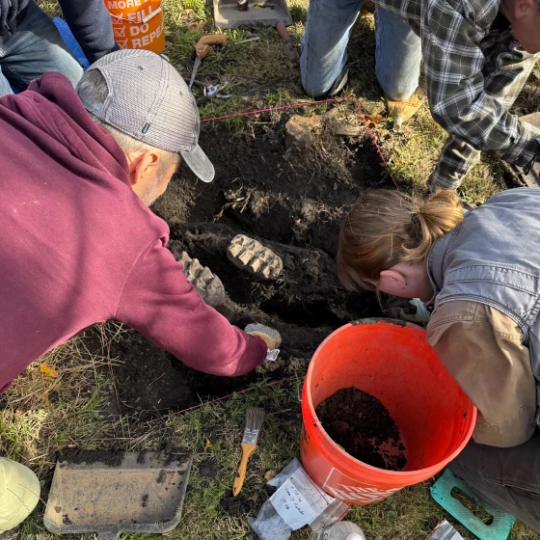


“While the jaw is the star of the show, the additional toe and rib fragments offer valuable context and the potential for additional research,” said Dr. Cory Harris, Chair of SUNY Orange’s Behavioral Sciences Department. “We are also hoping to further explore the immediate area to see if there are any additional bones that were preserved.”
The fossils will undergo carbon dating and analysis in order to determine just how long ago the mammal was roaming the area, what the diet consisted of, and details of its habitat, according to officials, who noted that the discovery will be featured in public programming starting in 2025.
“This discovery is a testament to the rich paleontological history of New York and the ongoing efforts to understand its past,” said Dr. Robert Feranec, director of Research & Collections and curator of Ice Age Animals at the New York State Museum. “This mastodon jaw provides a unique opportunity to study the ecology of this magnificent species, which will enhance our understanding of the Ice Age ecosystems from this region.”
About 150 mastodon fossils have been found to date across New York, about a third of which found in Orange County.

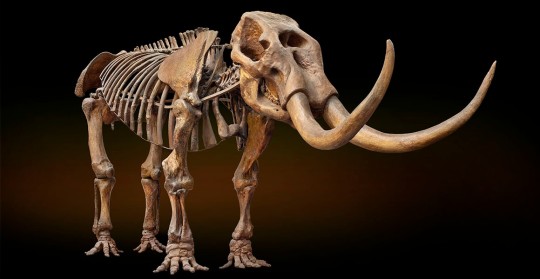
#Complete Mastodon Jaw Fossil Found in New York#Scotchtown#mastodon#prehistoric#fossils#paleontologists#ancient artifacts#archeology#archeolgst#history#history news#ancient history
44 notes
·
View notes
Text
Reblogging from you because you and so many others are detailing how awesome this last one is and I absolutely agree. Part of that is courtesy to Deinocheirus!
Deinocheirus literally translates to "horrible hand." These fossils, iirc, were the first we found of it! We didn't find any skulls or complete specimens until much later. Looking it up right quick, their arms alone were pretty darn imposing at nearly 8 feet/2.4 meters in length! The dinosaur as a whole is something like 36 feet/11 meters long. Buuut. These guys were omnivores, and when they did eat meat it was usually smaller. Basically, you probably wouldn't be lunch for one of these guys.
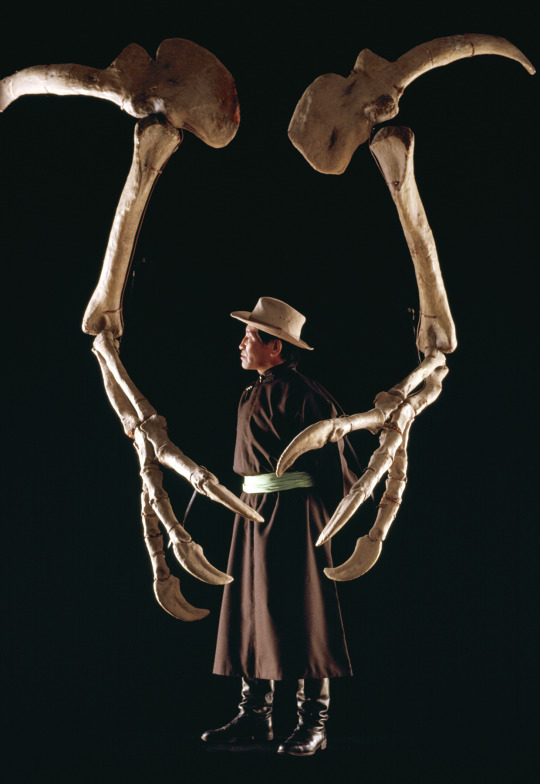
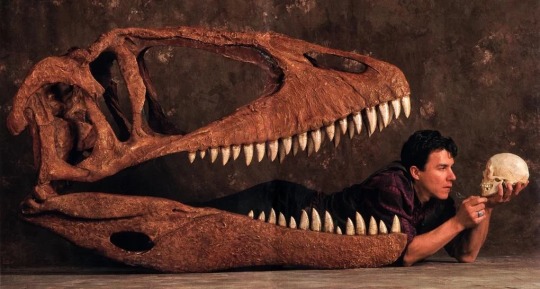
Short post of paleontologists absolutely slaying photo shoots with their discoveries. Please add more such images if you have them.
35K notes
·
View notes
Text
The Lancetfish is a species that looks like it comes straight out of a realistic fantasy world building project.
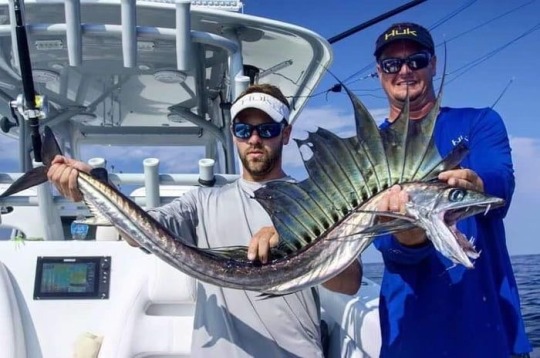
#speculative biology#speculative ecology#speculative evolution#speculative zoology#traditional art#traditional sketch#spectember#specposium#paleontology#fanart#paleo meme#paleo art#paleontologist#paleostream#paleobird#paleomedia#paleoblr#paleoillustration#paleoart#worldbuilding#world#fishing#world building#fantasy#realistic fantasy#fish#lancet fish#lancetfish
70K notes
·
View notes
Link
More than 255 million years ago, in what’s now South Africa, enormous amphibians floated and swam through the ancient shallows. Paleontologists know this not from petrified bones but from marks left in the sediment by the living creatures. The Dave Green paleosurface, in the eastern portion of South Africa’s Karoo Basin, is covered with the tracks and body impressions of amphibious creatures that grew to more than five feet in length. “The more you look, the more you find,” says paleontologist David Groenewald of the University of the Witwatersrand in Johannesburg.
Groenewald and colleagues described the fossils, attributed to animals called rhinesuchid temnospondyls, Wednesday in PLOS One. Formed near the end of the Permian Period, prior to the world’s worst mass extinction, the expanse of olive-green rock was laid down by rivers that threaded across the prehistoric landscape. Those waterways, it would seem, were home to large amphibious vertebrates that paleontologists know as temnospondyls—roughly salamander-like animals that could grow to impressive sizes, effectively the alligators of their time. While temnospondyl bones have given paleontologists a general idea of what these animals looked like, the trace fossils are effectively the prehistoric behavior of these animals locked in stone.
Continue Reading
93 notes
·
View notes